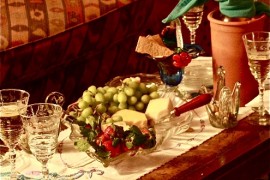I like to start every dinner in the living room with wine and cheese. Wine, cheese and fruit can relax the most nervous of new party guests. So I got a book, “Mastering Cheese.” Can you believe there is a book called “Mastering Cheese”?!? Max McCalman is a maître fromager. Who knew?
It is a beautiful book with lush photos and so much information about the history and making of cheese. In the introduction to the book, Max says, “Cheese has become my life mission, a passionate pursuit and a professional calling card far beyond any dreams or expectations.” Strong praise for something that some of us just think of as that slab of stuff on top of a cheeseburger. While certainly I appreciate cheese and know some wonderful ones, I am now humbled by my lack of knowledge. It turns out there are as many terms for cheeses and as wide a palate as for wine, another ancient food. What started as a way of preserving milk has become, over the millennia, an art form of great distinction. There is so much to know about real cheese!
The Romans left the first written accounts of cheese making. As their empire expanded they exported their cheeses and also added to their own repertoire with the local delicacies from their far flung territories, precursors of modern cheeses from England, Spain and France. Before empire, cheese was eaten right where it was made. So the cheeses, when they began to travel were named for the regions they came from. Brie actually came from Brie etc. Cheeses evolved in their separate regions made from local milk from local animals eating the plants grown in the local soil. Like wines they can be described by the flavors of the special place where they were made. Magic.
Yes, cheese is magical and flavorful and according to Max is good for you as well. In moderation, of course. Three of the highest per capita cheese consuming nations, France, Italy and Greece have long-lived populations and low rates of cardiovascular disease. Hence our fascination with what we in America have dubbed the Mediterranean diet.
Thankfully, now in the US artisanal cheesemaking is enjoying a lot of success. Whenever I go to Los Angeles, I always go to the Napa Grille and sample their cheese plate. Served on a marble slab with crusty bread, crackers and fruits, the chef features delicious cheeses from some of these small cheesemakers in the US. Always delicious. Once he served the cheeses with marinated raisins. Ooooh, I’d love to do that.
But for tonight….Yesterday I took “Mastering Cheese” into Whole Foods and asked them for a Portuguese raw sheep’s milk cheese called Azeitao. It’s renneted with thistle and the book says that the thistle gives it that familiar, pleasant bittersweet note. Well I’m not familiar with that “note” but I’ve decided to become familiar with it. There’s a photo in the book and the cheese looks like pudding, soft and creamy. The cheesemongers in Whole Foods are always so knowledgeable. Ms Monger tells me that they don’t have the Portuguese version but have a Spanish one called Torta Serena. She cut me a slice. Well, yes it does have an interesting note that I’ve never tasted.
So, I’m doing as instructed and I’ve left it out all day to soften. It’s beginning to look puddingy. I’ll serve it with some muesli bread and apple slices. I think a sparkling white. Just to sample.
Next week I think I’ll try a Piper’s Pyramid, a goat cheese from right here in the US, described as being in the same shape as a Valencay with a dusting of paprika on top and the occasional blue tinged mold on its rind (now I have to look up Valencay)….And I’ll study up on the ways to describe cheese, so I can bore all my friends with my new found esoteric knowledge…..


Leave a Reply